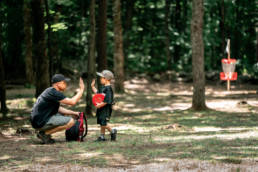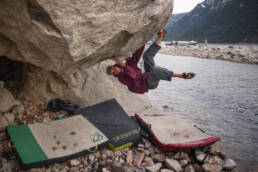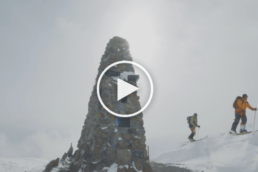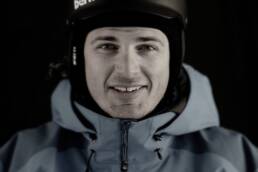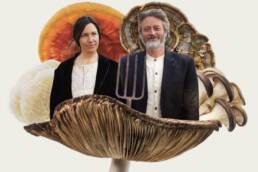Once for the fringe among us, disc golf has catapulted into one of the fastest-growing sports in the modern world. Let’s go for a walk in the chain-linked woods of Portland, Oregon, to toss a few wheels and find out why. By Mitchell Scott. Photographs by Alyssa Van Lanen.
A thick mist crawls through the towering firs of a classic Pacific Northwest rainforest. The flecks of rain that have made it through the canopy nip at giant ferns and iridescent moss. It’s beautiful and quiet, save for the odd burst of clattering chains accompanied by the sounds of people hooting. I’m playing disc golf with my son at Portland’s Pier Park, which is one of the more stunning chunks of urban wilderness I’ve been to. While we have lots of time to take it all in — the huge cypress trees and the bright fall colours — I am quite focused on a particular task, one that seems at odds with your typical walk in the park.

In my specialized backpack, I carry a dozen or so brightly hued plastic Frisbees, or “discs,” as they’re referred to by those in the know. I’ve got a Leopard, a Star Destroyer, a Lion, a well-worn Mako, and my trusty Aviar putter. Because this is the first time we have played this course, one of over a dozen in the Portland area, I use a GPS Google Maps guide app called UDisc to lead us through the 18 holes. It’s an early Sunday in November and the course is busy, mainly full of dudes, with the odd family and couple. Everyone is friendly as can be. If you play, you know the scene. If you don’t, well, read on. This sport is not your fringe hobby anymore; it’s blowing up.
Let’s break it down. Conceptually, disc golf is exactly the same as ball golf. There are tee pads. You chuck your driver disc to start, then move on to your mid-range, and finish with your putter, trying to get your disc into a chain-link basket with the fewest throws, or strokes, possible. Most holes are par threes that might stretch 250 to 350 feet. There are longer par fours and doglegs up to 700 or 800 feet. There are out-of-bounds areas, water hazards, and as you would expect, players jumping for joy after a long birdie or crumbling under the despair of a triple bogey. You won’t find golf carts or membership fees, manicured greens, sprinklers, or dress codes. Aside from your discs, which can run anywhere from $10 to $30 depending on the type of plastic, the game is free, although some higher-end and private courses do require a small green fee. It’s not the easiest sport to figure out — if you’ve never thrown a Frisbee before you can feel a little useless — but man, if you get a good drive and it S-curves, or “flexes,” through the sky for a few hundred feet, it feels pretty sweet. As the saying goes, “When a ball dreams, it dreams it is a Frisbee.”
Now, if you had some experience with the sport in its more formative era, like 10 or 15 years ago, I know what you’re thinking: you’re presuming disc golf is primarily for grubby slacker dudes more interested in smoking weed and drinking beers in the forest than, say, working. That demographic definitely likes to play. As do the hippies. But in 2019, that stereotype is wildly off base. This is a bona-fide, fast-growing sport, with professional men’s and women’s tours led by hip millennials who can chuck the disc really, really far. They also regularly sink putts from 60 feet and have an arsenal of sidearm, overhead, and backhand shots — there’s even a roller shot! Some, like Eagle McMahon, Ricky Wysocki, and Paige Pierce, are making six-figure annual salaries. Companies like Discraft, Innova, and Discmania, which manufacture discs, have been enjoying a legitimate boom in sales over the last five years. The poster boy for all of disc golf’s steamrolling hype, however, is Paul McBeth, a 29-year-old pro from Huntington Beach, California. As a five-time PDGA (that’s Professional Disc Golf Association) world champion, he’s often referred to as the best player in the sport’s history. His winnings and endorsements during his 14-year career are estimated to total over US$477,000. He also recently signed a four-year sponsorship deal with Discraft worth $1 million. “McBeast,” as he’s known, even has his own private course in Virginia. Not bad for chucking wheels.
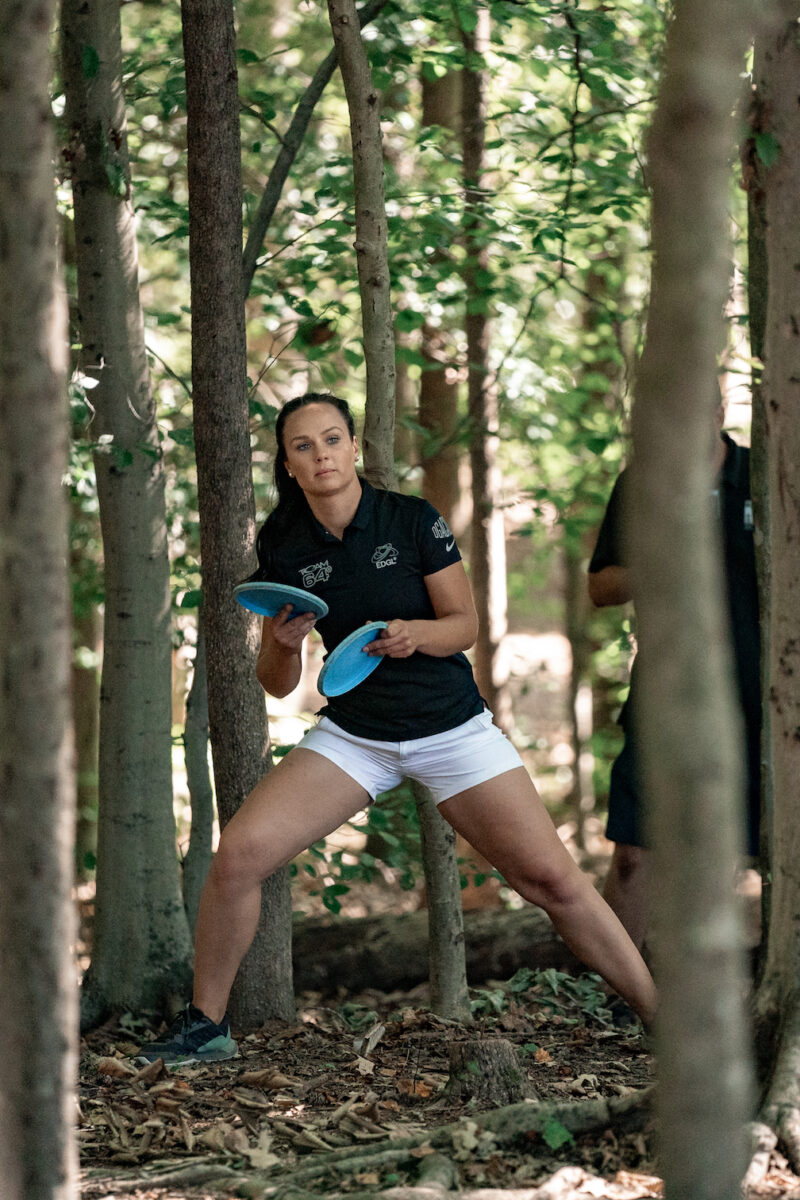
THE SPORT HAS COME a long way since the first course was built in 1975 in Pasadena, California’s Oak Grove Park. Today, according to the PDGA, there are close to 6,300 courses in the US, and as traditional ball golf courses struggle to keep the doors open, they are adding disc golf to their infrastructure. Sacrilege! Additional statistics from the PDGA suggest that disc golf could outpace ball golf in the next 20 years. There are approximately 11,000 ball golf courses in the US, with an average decline of 100 courses per year. Compare that to the disc golf courses popping up around North America at a breakneck pace, about 500 per year, per the PDGA. Yes, every khaki-wearing, middle-aged white man’s country-club nightmare is being realized: the iGeneration, Gen Z, and the middle class are coming. An estimated 500,000 regular disc golfers are playing worldwide, and get this: in 2018, 260,000 PDGA pro-tour competitors participated in over 4,000 different events. There’s even a disc golf iPhone game. And, oh yeah, it’s big in Scandinavia. Which, as we all know, means it’s cool.
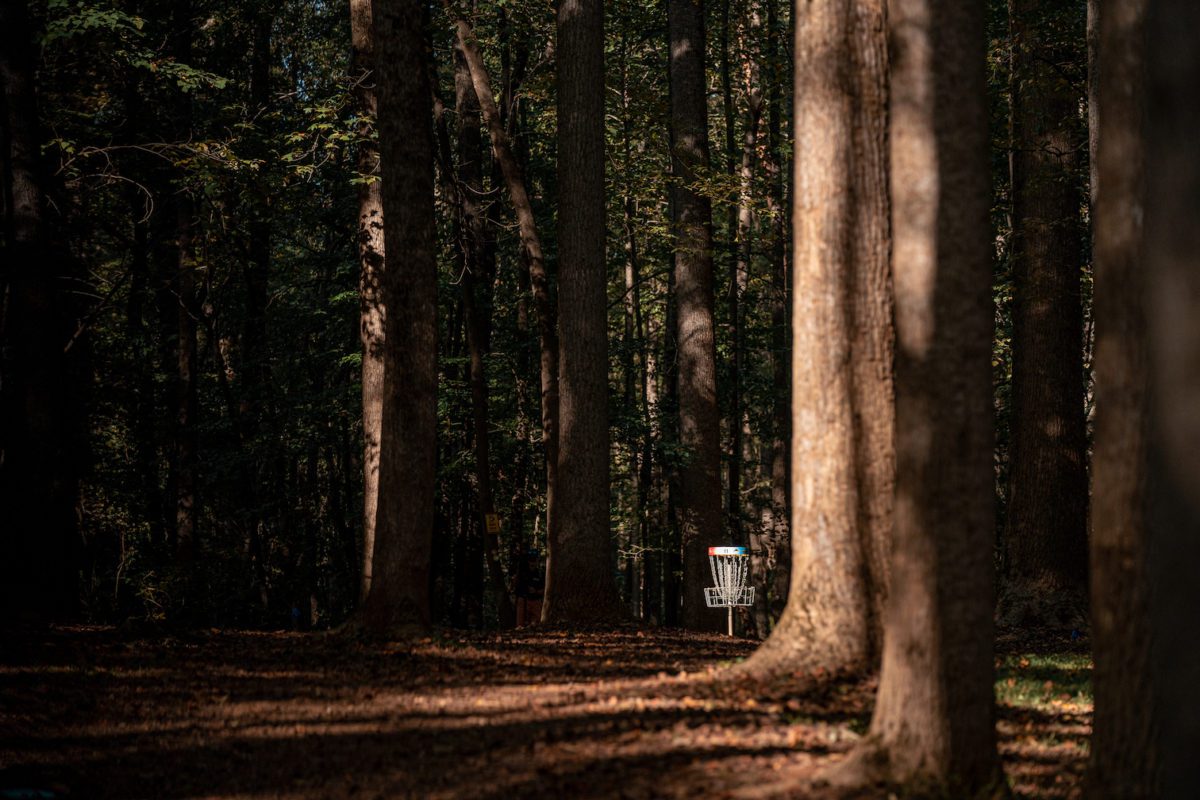
So, if you’re thinking the sport’s meteoric rise is altogether weird, and perhaps not true, search for the final back nine at the 2019 world championships in Nokia, Finland, next time you’re killing time on the internet. The proof is there: smartly dressed male and female pro disc golfers being followed by a gallery a few thousand strong. Cameras, quiet banners, caddies, the works. In fact, many think video coverage of the pro tour has played a major role in the sport’s recent growth. Views on Youtube of disc golf tournaments increased a whopping 2,900 per cent from 2013 to 2018, from one million to just over 30 million. I even started watching them, and while it felt strange at first, I now find it oddly soothing.
There are 82 disc golf courses in British Columbia; Washington has 145 and Oregon has 134. Disc golf gets people, especially youth, off their screens and outside. Let’s face it, walks or hikes can be a little boring, bicycling a little dangerous, team sports a bit of an organizational hassle, and running, well.

Back in Pier Park, my son, who is a 21-year-old university student, is really starting to have a time by our third round. He has some experience throwing a Frisbee but has never played real disc golf before. He likes it. A lot. Truthfully, you really have to chuck the thing, which doesn’t always feel graceful. Shanks, overthrows, tree doinks, worm burners, misfires, they’re all real and frequent outcomes, even for experienced players, which can be demoralizing for a new player. But unlike eating shit on your mountain bike or getting outmuscled on the soccer pitch, it’s just the ego getting bruised. None of his friends play at Simon Fraser University, nor is there a course on the Burnaby, British Columbia, campus, but because disc golf is everywhere, there’s a beautiful little nine-hole course nine kilometres (six miles) away in Robert Burnaby Park. Regardless of whether he pursues the sport, perhaps one of the best things about it is that his barriers to entry are minimal. In the not too distant future, he might find himself surrounded by thousands of young people keen on in hitting the links — the real chain-links.
To help ease the stress of his role as editor-in-chief of Kootenay Mountain Culture Magazine, Mitchell Scott enjoys the odd round of disc golf with his mates and their dogs. His retirement dream is to one day play on the senior men’s pro tour.
Mitchell Scott
Mitchell Scott is the longtime Editor-in-Chief and co-publisher of both Kootenay Mountain Culture and Coast Mountain Culture Magazines. He's been in the writing/publishing/media business for over 20 years and currently lives in Nelson, BC, where he tries to keep up with his two teenage sons with aching futility.
Related Stories
Why The West Kootenay Bouldering Scene Is Blowing Up
On the heels of the announcement that Ladybird Creek Bouldering area in the Slocan Valley is now a BC Recreation Site,…
Why You Tour Contest
This has nothing to do with our magazine, other than the fact that we're big fans of CMH (Hans Gmoser is a Kootenay…
Why Japan Skiing is Awesome
For the past two seasons, Washington student and videographer Mattias Evangelista has skied the slopes and documented…
Why Locals Ski Naked in Golden, BC
Every summer, indecently exposed to the sun’s sizzle and with winter’s last vestige all but shrivelled up, boarders…
Why Do You Ski (or surf…or ride…or kayak…or…)?
An interesting little film here..the trailer for Lifted was released this past weekend at the Leavenworth Film…
Why Kootenai Fungi is The Shiitake
The Kootenai Fungi business in Kimberley, British Columbia, may have an unorthodox farming style, but its crops are the…


